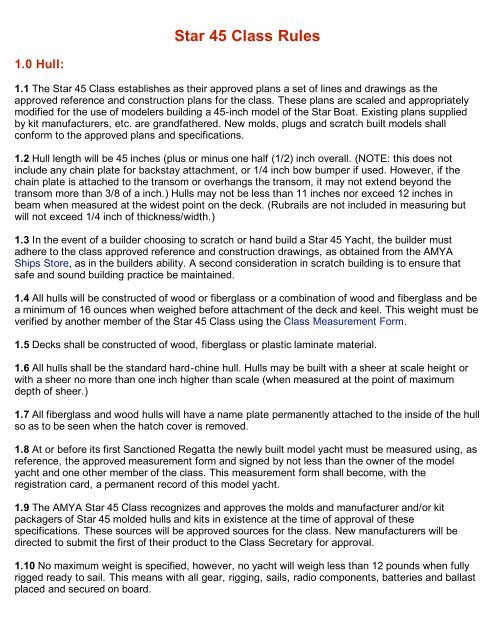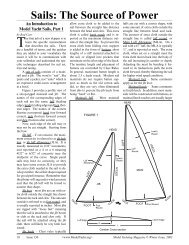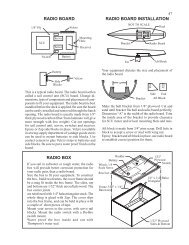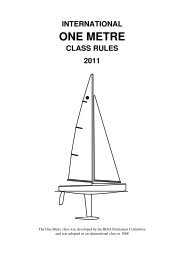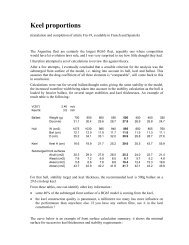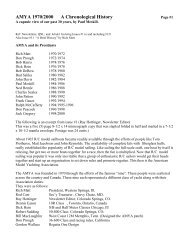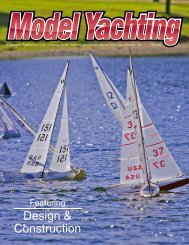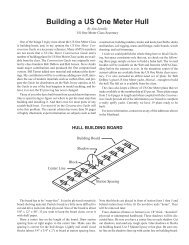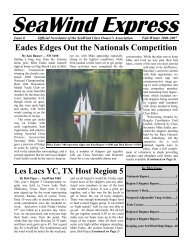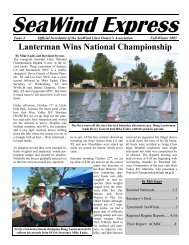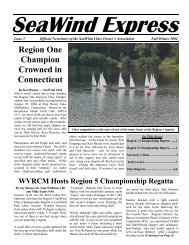Star 45 Class Rules
Star 45 Class Rules
Star 45 Class Rules
You also want an ePaper? Increase the reach of your titles
YUMPU automatically turns print PDFs into web optimized ePapers that Google loves.
1.0 Hull:<br />
<strong>Star</strong> <strong>45</strong> <strong>Class</strong> <strong>Rules</strong><br />
1.1 The <strong>Star</strong> <strong>45</strong> <strong>Class</strong> establishes as their approved plans a set of lines and drawings as the<br />
approved reference and construction plans for the class. These plans are scaled and appropriately<br />
modified for the use of modelers building a <strong>45</strong>-inch model of the <strong>Star</strong> Boat. Existing plans supplied<br />
by kit manufacturers, etc. are grandfathered. New molds, plugs and scratch built models shall<br />
conform to the approved plans and specifications.<br />
1.2 Hull length will be <strong>45</strong> inches (plus or minus one half (1/2) inch overall. (NOTE: this does not<br />
include any chain plate for backstay attachment, or 1/4 inch bow bumper if used. However, if the<br />
chain plate is attached to the transom or overhangs the transom, it may not extend beyond the<br />
transom more than 3/8 of a inch.) Hulls may not be less than 11 inches nor exceed 12 inches in<br />
beam when measured at the widest point on the deck. (Rubrails are not included in measuring but<br />
will not exceed 1/4 inch of thickness/width.)<br />
1.3 In the event of a builder choosing to scratch or hand build a <strong>Star</strong> <strong>45</strong> Yacht, the builder must<br />
adhere to the class approved reference and construction drawings, as obtained from the AMYA<br />
Ships Store, as in the builders ability. A second consideration in scratch building is to ensure that<br />
safe and sound building practice be maintained.<br />
1.4 All hulls will be constructed of wood or fiberglass or a combination of wood and fiberglass and be<br />
a minimum of 16 ounces when weighed before attachment of the deck and keel. This weight must be<br />
verified by another member of the <strong>Star</strong> <strong>45</strong> <strong>Class</strong> using the <strong>Class</strong> Measurement Form.<br />
1.5 Decks shall be constructed of wood, fiberglass or plastic laminate material.<br />
1.6 All hulls shall be the standard hard-chine hull. Hulls may be built with a sheer at scale height or<br />
with a sheer no more than one inch higher than scale (when measured at the point of maximum<br />
depth of sheer.)<br />
1.7 All fiberglass and wood hulls will have a name plate permanently attached to the inside of the hull<br />
so as to be seen when the hatch cover is removed.<br />
1.8 At or before its first Sanctioned Regatta the newly built model yacht must be measured using, as<br />
reference, the approved measurement form and signed by not less than the owner of the model<br />
yacht and one other member of the class. This measurement form shall become, with the<br />
registration card, a permanent record of this model yacht.<br />
1.9 The AMYA <strong>Star</strong> <strong>45</strong> <strong>Class</strong> recognizes and approves the molds and manufacturer and/or kit<br />
packagers of <strong>Star</strong> <strong>45</strong> molded hulls and kits in existence at the time of approval of these<br />
specifications. These sources will be approved sources for the class. New manufacturers will be<br />
directed to submit the first of their product to the <strong>Class</strong> Secretary for approval.<br />
1.10 No maximum weight is specified, however, no yacht will weigh less than 12 pounds when fully<br />
rigged ready to sail. This means with all gear, rigging, sails, radio components, batteries and ballast<br />
placed and secured on board.
1.11 Bow Bumpers are mandatory for all class registered STAR <strong>45</strong> yachts. Bow bumpers are limited<br />
to three eight's of an inch (3/8") overhang. Bow bumpers shall be excluded in the overall length<br />
measurement, whether recessed in or otherwise attached to the bow stem. Bow bumpers must be of<br />
resilient fabrication to minimize damage to another yacht in the event of a collision.<br />
2.0 SAILS:<br />
2.1 Sails may be of single or multi-paneled construction. Sail material shall be unrestricted.<br />
2.2 All sails are to be cut to comply with the following maximum dimensions when measured by the<br />
procedure as outlined in the "AMYA Regulations". Dimensions shown are measured 'Edge of Cloth"<br />
to "Edge of Cloth" and are in inches.<br />
2.3<br />
MAIN JIB<br />
Luff 62.75 42.50<br />
Foot 25.50 15.75<br />
Leech 65.50 37.00<br />
Roach 2.00 0.50<br />
Head 0.75 0.75<br />
Foot Round 0.50 0.50<br />
2.4 All sails, main and jib, will be cut with either a straight head to clew leech with no roach, or a fair<br />
curved head to clew leech with the maximum roach point occurring approximately one half the<br />
distance from the clew to head. Divide a straight line from the aft corners of the Clew and Head into<br />
four (4) equal sections. Then, for the Main Sail, maximum offset from edge of cloth for the Roach at<br />
the quarter points to be 1.75" and the offset at the mid-point to be 2.0". For the Jib, the offset at the<br />
quarter points to be 0.375" and at the mid-point to be 0.50". Sails cut with a straight leech at the<br />
maximum roach allowance are prohibited from use on the <strong>Star</strong> <strong>45</strong> <strong>Class</strong> Yacht.<br />
2.5 The mainsail gooseneck or attachment will be attached to the Mast between 0.50 inch minimum<br />
to 4.0 inch maximum measured from the deck.<br />
2.6 Battens are allowed on the mainsail but are restricted to 4 in number, equally spaced along the<br />
leech and may not exceed 8.50 inches in length. Battens are not permitted in the jib sail.<br />
2.7 Sailmakers must conform to the above measurements.<br />
2.8 Standing rigging is not specified except for the height of the jib stay attach point on the mast,<br />
which will not exceed 54 inches above the deck when measured from the deck at the mast step<br />
point, and mast head fittings are limited to a projection of 3.0 inches behind the mast. Control of<br />
standing rigging by other than manual manipulation (Hand Turning) is prohibited.
2.9 The <strong>Class</strong> Secretary maintains a master sail measurement template. Sail measurement<br />
templates shall be kept current with the class specifications as well as new motions passed by the<br />
rank and file. Templates shall be made of material consistent of lasting shape. Templates shall be<br />
made available for AMYA sanctioned regattas upon request from the hosting AMYA sanctioned club.<br />
Other non-sanctioned regattas may request templates which is subject to availability and discretion<br />
of the <strong>Class</strong> Secretary.<br />
3.0 MAST:<br />
3.1 Masts shall be made of wood or aluminum. Swing rigs, rotating and permanently bent masts are<br />
prohibited.<br />
3.2 Masts shall not exceed 3/4 inches square when measured at the thickest point of the mast.<br />
Maximum mast height shall be 70" when measured from the deck, inclusive of the crane. Rotating<br />
wind indicators and burgee staffs are not included provided the backstay is not attached to them in<br />
order to circumvent the 70" maximum mast height specification.<br />
4.0 BOOMS:<br />
4.1 The main boom and jib club shall not exceed 5/8" when measured at the thickest point. Booms<br />
and jib clubs shall be constructed of wood, aluminum and/or fiberglass.<br />
5.0 RADIO CONTROL SYSTEMS:<br />
5.1 Radio control systems of any number of channels may be used but the functions are limited to<br />
the rudder, sail control (jib sheets and main sheet) using no more than three servos. Control of the<br />
jib may be separate or may be combined in one function.<br />
6.0 RUDDER:<br />
6.1 Rudders may be constructed of wood, fiberglass, plastic, plastic laminates or metal. The exact<br />
shape is not specified, but they may not exceed 4 1/2 inches at the hull (fore and aft) 3 inches at the<br />
bottom, (fore and aft); and may not project more than 7 inches below the hull when measured at the<br />
post.<br />
7.0 KEELS AND BALLAST BULBS:<br />
7.1 Keel will be of the style known as drop, and will be of the FIN and BULB type.<br />
7.2 Keel fins may be solid or hollow and constructed of reinforced plastic, plastic laminates,<br />
fiberglass, wood or metal. (Note: Strength and integrity of the keel fins must be maintained whether<br />
built solid or hollow.) Keel fin shape is not specified but must follow the general shapes outlined on<br />
the reference drawing. However, keels will not be less than 6 inches nor more than 8 inches long<br />
(Fore and Aft) at the keel/hull junction, nor less than 4 inches nor more than 6 inches long (Fore and<br />
Aft) at the keel/ballast bulb junction.
7.3 Keels, keel fins and ballast bulbs may be removable, however, they may not be changed,<br />
interchanged, substituted or otherwise manipulated once any heat or series of heats in which scores<br />
will be compiled, has started. Mechanically movable keels or ballast bulbs are specifically prohibited<br />
from use in <strong>Star</strong> <strong>45</strong> <strong>Class</strong> Yachts.<br />
7.4 Ballast bulbs may be constructed of any material not prohibited by the AMYA. The actual shape<br />
is left to the builder's discretion, but will not exceed 9.75 (9 3/4) inches from the front of the keel bulb<br />
to the rearmost point of the keel or bulb.<br />
7.5 Total drop (length) of the keel fin/ballast bulb combination will not exceed 11.5 (11 1/2) inches<br />
when measured from the keel/hull junction, before any fillers or streamlining is added.<br />
7.6 Ballast may be made from any readily available material, such as poured lead, lead shot, etc.<br />
(Note: When using material such as lead shot, the mass must be solidified through the use of a<br />
bonding agent such as fiberglass or epoxy resin, plaster of paris, poured over and through in order to<br />
create a solid mass.)<br />
7.7 Race directors may elect to use a template based on the construction plans to determine the keel<br />
length (depth).<br />
7.8 Keel depth shall be measured from the center of the keel fin at the hull to the bottom of the<br />
ballast bulb. This measurement is from the edge of the bottom of the hull as it meets the side of the<br />
keel and should be determined during construction and before any fillet or fairing is added.<br />
7.9 The <strong>Star</strong> <strong>45</strong> <strong>Class</strong> specifically excludes radio equipment, sail controls and batteries (power cells)<br />
from being considered ballast. This specification defines ballast as anything carried aboard the<br />
model for the main purpose of changing the weight distribution of the model and/or weight of the<br />
model. Ballast shall be fixed in place by gluing, fiberglassing, or bolting (bolts and screws).<br />
7.9.1 Ballast may not be removed or relocated during any one regatta. The use of Velcro or similar<br />
quick release fasteners is prohibited as methods of mounting ballast.<br />
8.0 DECK:<br />
8.1 Deck construction shall be limited to wood, plywood, fiberglass reinforced plastic or plastic<br />
laminations (Formica). It may be covered with any material. Thin plastic films, such as MonoKote,<br />
are not allowed for decks except as coverings.<br />
8.2 Hatches are not restricted in size, location, number or style, as long as deck strength and<br />
integrity are maintained.<br />
9.0 DISTINGUISHING MARKS:<br />
9.1 Each yacht shall carry on her main sail the class 5 point "STAR EMBLEM" and an assigned<br />
AMYA registration number. The star shall be at least 2 inches in size (measured from point to point<br />
across the flat of the star) and positioned above the registration number. Registration numbers shall<br />
be at least 3 inches in height and at least 3/8 inch thick. Both star and registration numbers will be<br />
placed on the upper half of the mainsail on both port and starboard sides of the mainsail and shall be<br />
positioned so as to be easily read from either side.
10.0 MANUFACTURERS PROCEDURES:<br />
10.1 The following are procedures that must be followed by manufacturers, class secretaries and<br />
scratch builders, who are going to make more than one hull for sale.<br />
10.1.1 The builder shall send to the class secretary proof of craftsmanship, hull by means of<br />
transportation of the builder's choice.<br />
10.1.2 The class secretary will, upon receiving hull for measurement, notify the builder of the<br />
condition of the hull.<br />
10.1.3 The class secretary will measure the hull.<br />
10.1.4 When measuring hull the class secretary will request a <strong>Star</strong> <strong>45</strong> owner to assist with the<br />
measuring.<br />
10.1.5 The class secretary will measure the hull, using the templates of the hull pictured in the<br />
approved plans.<br />
10.1.6 The templates will be made of Plexiglas or wood (not Balsa).<br />
10.1.7 The membership can request a copy of these templates by sending a request to the class<br />
secretary. These templates have been taken from the approved plans and are true and accurate.<br />
10.1.8 The class secretary upon completion of the measuring will return the hull to the builder. The<br />
class secretary will also assign a number for the hull, if approved. Each hull will be measured<br />
regardless of condition. The manufacturer will keep in his possession a record of as to whom he sold<br />
hulls.<br />
11.0 AUTHORIZATION FOR CLASS SECRETARY:<br />
11.1 The class secretary shall be authorized to conduct class business such as granting interim<br />
approval to molds, manufacturers and similar approvals provided those actions are reported in the<br />
newsletter.<br />
12.0 SPECIFICATIONS:<br />
12.1 These specifications shall take precedent over any other document.
STAR <strong>45</strong> CLASS<br />
Measurement Form<br />
____________________________________________ ___________________<br />
Skipper or Owner Registration Number<br />
HULL:<br />
Fiberglass:____________ Wood: ______________<br />
Length: <strong>45</strong>” +- 1/2” (Rule 1.2) ________________<br />
Width: 11” to 12” (Rule 1.2) ________________<br />
Hull Weight (Rule 1.4) ________________<br />
Deck Material (Rule 1.5) ________________<br />
Name Plate attached (Rule 1.7) ________________<br />
Bow Bumper installed (Rule 1.11) ________________<br />
Any attachment or fitting that extends beyond the hull when measured vertically from the edge of the hull (and<br />
perpendicular to the waterline) is to be considered part of the overall length of the hull and rule 1.2 applies<br />
SAILS:<br />
Measured “Edge of cloth to edge of cloth” (Rule 2.2) Maximum Roach is 2.0” on Mainsail and 0.5” on Jib (Rule 2.3)<br />
Luff Foot Leech Roach Head Foot Round<br />
Main: 62.75 _______ 25.50 _______ 65.50 ______ 2:00 ______ 0.75 _____ 0.50 ___<br />
Jib: 42.50 _______ 15.75 _______ 37.00 _______ 0.50 _______ 0.75 ______ 0.50 ___<br />
MAST & RIGGING:<br />
Aluminum _______ Wood ______ (Rule 3.1)<br />
Mast Crane not to exceed 3” behind mast (Rule 2.8) ___________<br />
Jib stay attachment not to exceed 54” above deck (Rule 2.8) ___________<br />
Mast Length not to exceed 70” above deck (Rule 3.2) ___________<br />
Mast not to exceed 3/4” square (Rule 3.2) ___________<br />
Aluminum ______ Wood _______<br />
Boom and Jib Club not to exceed 5/8” square (Rule 4.1) ___________<br />
Aluminum _______ Wood ________ Fiberglass ___________<br />
If any part of the jib club, any jib club attachment, or any counterweight extends beyond the bow of the boat<br />
when measured vertically from the leading edge of the bow, it needs to be included in the total length of the hull and<br />
may not then exceed <strong>45</strong>.5 inches as per rule 1.2<br />
Rear Chain plate cannot extend past transom more than 3/8” ___________<br />
from a vertical line perpendicular to the water line (Rule 1.2)<br />
RUDDER:<br />
May not exceed 4.1/2” at Hull: ______, 3.0” at bottom: ______, and shall not project ___________<br />
more than 7.0” below the Hull at post: ______ (Rule 6.1)<br />
Rudder post position from stern 6” as per drawing ___________<br />
2003 revision<br />
1
KEEL & BULB:<br />
2003 revision<br />
STAR <strong>45</strong> CLASS<br />
Measurement Form<br />
Bulb to be of a length not greater than 9.3/4” (Rule 7.4) ________<br />
Keel width not to exceed 8.0” or less than 6.0” when _________<br />
measured at the Hull (Rule 7.2)<br />
Keel width not to exceed 6.0” or less than 4.0” when __________<br />
measured at the keel/ballast bulb junction (Rule 7.2)<br />
Maximum depth of keel and bulb will not exceed 11.1/2 __________<br />
total drop (Rule 7.5)<br />
WEIGHT:<br />
Total weight cannot be less than 12 lb. including all gear, ___________<br />
rigging, sails, radio components, batteries and ballasting (Rule 1.10)<br />
HULL MANUFACTURER:<br />
Self Built: _________ Manufacturer: ____________<br />
SAIL MANUFACTURER:<br />
Self Built: __________ Manufacturer: ____________<br />
REMARKS:<br />
________________________________________ _______________________________<br />
Skipper or Owner Measurer<br />
_________________________________________ ________________________________<br />
Date<br />
2<br />
_________________________________<br />
Note:<br />
These are the minimum measurements to be performed at regattas. This is not the definitive list of class rules. The<br />
written rules and the plans need to be considered together for the actual rules in totality.<br />
This minimum list of required measurements is subject to change and other rules may be verified or measured.<br />
Therefore this should not be used as a guideline for building in and of itself, but merely as it is written and intended,<br />
that is it being the current measurement check-in for officially sanctioned regattas.


